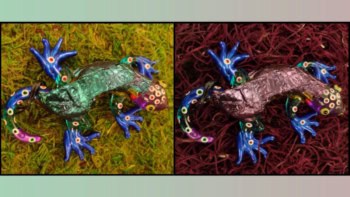
Just as topological insulators provide protection to electrons travelling along their edges and surfaces, photons can also be topologically protected. This can occur when photon scattering modes are associated with just one spin state. Now, researchers in India and the Netherlands have found that spin-selective or spin asymmetric scattering modes can be observed using a twisted nematic-liquid-crystal-based spatial light modulator. Their work indicates that liquid crystals can host topological states by controlling the interaction between disorder of the material and the spin-orbit interaction of light.
Topology goes photonic
Topology is the field of mathematics concerned with geometric objects that do not change when continuously deformed. Properties that are invariant when deformed are said to be topological. Recently, physicists have become more and more interested in applying topological principles in physical systems with a view to exploiting topological invariance whereby particles are not affected by local perturbations. A spin-polarized current of electrons, for example, can flow without scattering in topological materials that could have significant technological applications. Although much of the research focus has been on electronic, many research groups are now turning their attention to photonics.
In the case of photons, topological protection can arise when photons travelling through a medium are controlled so that their spin is “locked” to a particular propagation direction. This can be achieved by controlling the interplay between the spin angular momentum of the beam (its circular polarization) with its orbital angular momentum. When travelling through certain materials, it is thought that a Gaussian beam can be manipulated so that its scattering modes are spin selective.
Shining a light on anisotropic materials
In their recent study, published in Physical Review A, Ankit Kumar Singh and colleagues at the Indian Institute of Science Education and Research Kolkata and Delft University of Technology have demonstrated a method for producing spin-selective scattering modes in the Fourier spectrum of a Gaussian beam passing through a liquid crystal-based modulator.

3D topological insulators go photonic
Their experiment used a helium-neon laser to produce a Gaussian beam which was spatially filtered and then linearly polarized. The beam then passed through the medium — a transmission spatial light modulator made of a liquid crystal. This had properties that could be controlled using an applied voltage, resulting in a random phase distribution. Following this, the beam was passed through a polarization state analyser consisting of a quarter wave plate and another polarizer. This enabled researchers to measure the distribution of left circularly polarized and right circularly polarized light once the beam was focused onto a photodetector.
They found that randomly scattered modes were only observed for the right circularly polarized projection, whereas the left circularly polarized projection showed no scattering modes. From this, they concluded that the randomly scattered modes only occur for one spin state of the light, while the other travels through the medium mostly unaffected by the disorder of the system.
The future of photonics
Though still in its infancy, the field of topological photonics provides exciting possibilities for the future of light-based technologies. Potential applications of spin-controlled photon systems range from high-resolution imaging techniques to microparticle trapping. Understanding the topological properties of light as it interacts with different materials will enable researchers to develop more robust technologies in the future.



